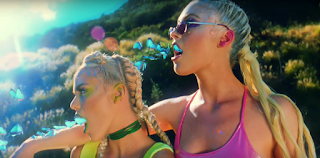The ‘Butterfly Effect’ is the concept that small causes can have large effects. Travis Scott is also using a double-entendre with “butterfly” as he also refers to the doors on his Lamborghini car. Travis describes his new life, how great it is, and how he could never go back to the old one. The production on this song is by Murda Beatz: 'Murda on the beat so it's not nice', who is producing a lot of the upcoming Travis Scott and Quavo collaboration album.
Techniques:
 Different techniques used in this music video are mainly lip-syncing, and very fast cutting to the beat. Lip-syncing is a very common them in this genre as it almost is hand in hand with the Performance style. Cutting to the beat is also very common amongst rappers as it makes the video a lot more aesthetic to watch as it is in rhythm and will flow much better.
Different techniques used in this music video are mainly lip-syncing, and very fast cutting to the beat. Lip-syncing is a very common them in this genre as it almost is hand in hand with the Performance style. Cutting to the beat is also very common amongst rappers as it makes the video a lot more aesthetic to watch as it is in rhythm and will flow much better.Styles:
 The styles used in this music video are Interpretive Narrative and Performance along with stylish special effects. The narrative can be perceived in many different ways depending on how you look at it as well as your own personal culture or background. Or even just how you listen to the Hip-Hop genre itself. Again, the common them of performance is shown by Travis as in Hip-Hop's culture many rappers want to show off their material assets, mainly through jewellery, cars, fashion and women.
The styles used in this music video are Interpretive Narrative and Performance along with stylish special effects. The narrative can be perceived in many different ways depending on how you look at it as well as your own personal culture or background. Or even just how you listen to the Hip-Hop genre itself. Again, the common them of performance is shown by Travis as in Hip-Hop's culture many rappers want to show off their material assets, mainly through jewellery, cars, fashion and women.Representations:
Whilst Travis is sometimes criticised for 'rapping about nothing', critics have found a clear theme emerging from his most recent songs - Monarch programming. It appears that Travis is now promoting the elite’s MK symbolism to his thousands of young fans. When a new artist shows talent, charisma and star potential, it doesn’t take long before they get recruited by the elite. Afterwards, their work becomes “tainted” with their agenda. For example - Butterfly Effect. Monarch Programming is a method of mind control used by numerous organisations. It is a continuation of the project MK-ULTRA, which is a mind-control program developed by the CIA, and tested on both the military and civilians. The methods are extremely vicious; its entire purpose is to traumatize the victim. The results are just as horrifying due to the creation of a mind-controlled slave can be triggered at anytime to perform any action required by 'the handler'. While mass media has ignored the issue, over 2 million Americans have been put through the horrors of this program. For immediate proof, this screenshot taken from the video of Travis spitting out Butterflies after being struck by lightning. Also notice how his brain is all road showing that he is being controlled.
In the video, Travis rides around in sports cars while girls dance around him erotically and perform as part of the male gaze. However, the symbolism surrounding the women really implies that they are all owned by an extremely oppressive system.
Here, one model licks and bites into an apple with butterflies printed on it. This is a very symbolic way of representing them being drugged for MK programming. As this image is along side the lyrics of 'M&M's, sweet like candy cane'. Clearly referencing MDMA and Ecstasy pills.
Here, the models are blatantly just spitting out butterflies - a clear of showing they are under Monarch slavery.
Nearing the end of the video, Travis gets struck by lightning, being completely undertaken by this culture.
Of course this is just one representation of the music video, however it is actually a common them in hip-hop music videos at the moment such as in Lil Uzi Vert's 'XO Tour Lif3' and Playboi Carti's 'Magnolia', therefore needs to be addressed. Here is a further example of Travis and SZA with the Monarch Butterflies:





































